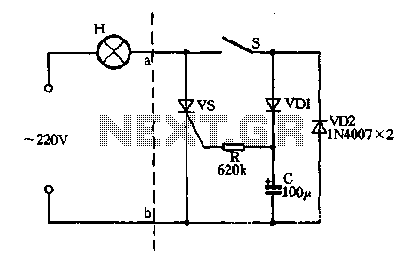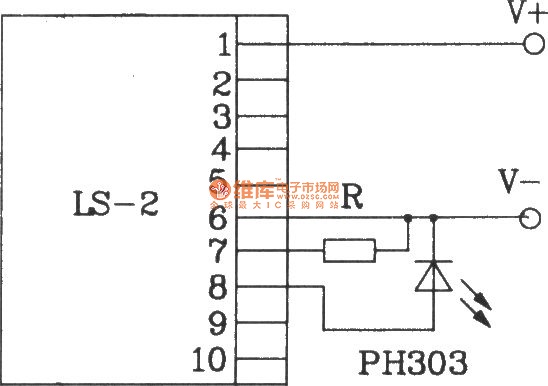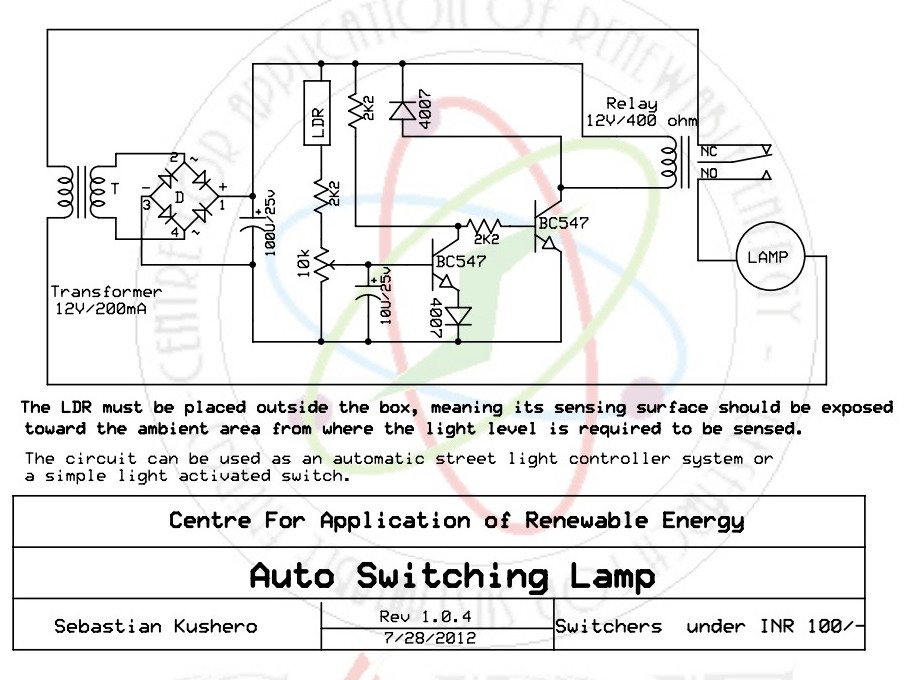
Novel delay lighting switch circuit

Closing the switch S allows the AC positive half-cycle to flow through diode VDI and resistor R, causing the SCR to open simultaneously at both ends of the capacitor C, which becomes fully charged. During this phase, the positive half-cycle of the alternating current powers the lamp H, while the negative half-cycle flows through diode VD2 to the bulb H, thereby supplying total voltage to the lamp H. When the switch S is turned off, the capacitor C discharges through the resistor R. The discharge current keeps the SCR conducting, allowing the lamp H to illuminate during the positive half-cycle of the current. However, since switch S interrupts the negative half-cycle power supply in the VD2 loop, the lamp H operates in a reduced voltage state, resulting in a dim light. After approximately one minute, as the capacitor C discharges, the gate trigger current for the SCR diminishes at the zero crossing of the AC signal, which ultimately causes the lamp to extinguish.
The described circuit utilizes a switch (S) to control the charging and discharging of a capacitor (C) in conjunction with a silicon-controlled rectifier (SCR) and diodes (VDI and VD2) to manage the flow of alternating current (AC) to a lamp (H). When the switch S is closed, the positive half-cycle of the AC voltage is directed through diode VDI and resistor R, allowing the capacitor C to charge. The SCR, once triggered, allows current to pass through to the lamp H, illuminating it during the positive half-cycle.
During the negative half-cycle, diode VD2 conducts, providing an alternative path for current to flow to the lamp H, ensuring that it remains powered. This dual-path operation allows the lamp to receive continuous power, even as the AC cycle alternates. When the switch S is opened, the capacitor C begins to discharge through the resistor R. The SCR remains conductive due to the discharge current, which sustains the light output from the lamp H. However, the interruption of the negative half-cycle by opening switch S leads to a reduction in the effective voltage across the lamp, causing it to dim.
The circuit's operation is dependent on the timing of the capacitor's discharge and the characteristics of the SCR, which requires a gate trigger current to remain conductive. As the capacitor discharges, the gate current diminishes until it reaches a threshold where the SCR can no longer sustain conduction. This occurs at the zero crossing of the AC voltage, resulting in the lamp H turning off.
This configuration is useful in applications where a controlled dimming effect is desired, allowing for gradual illumination and extinguishing of the lamp, enhancing user experience while managing power effectively. The design can be implemented in various lighting applications, providing both functionality and efficiency in AC-powered lighting systems.Closing the switch S, AC positive half cycle through VDI, R vs SCR opened simultaneously at both ends of the capacitor C is full charge. In this case the positive half cycle alternating current through the lamp H vs power, negative half-cycle through the
diode VD2 to the bulb H power, so in this case the lamp H total pressure supply. When you turn off the lights, turn on the switch S, the capacitor C discharges through the resistor R, the discharge current is maintained vs SCR continues to conduct, so light bulbs H in the positive half cycle of the current through the still, but because S cut off the negative half cycle of the power supply VD2 loop, so the lamp H in a semi-state voltage power supply, lamp dark light. About 1 minute after the capacitor C is discharged, the loss vs SCR gate trigger current at the zero crossing of the AC off, the lamp goes out.
The described circuit utilizes a switch (S) to control the charging and discharging of a capacitor (C) in conjunction with a silicon-controlled rectifier (SCR) and diodes (VDI and VD2) to manage the flow of alternating current (AC) to a lamp (H). When the switch S is closed, the positive half-cycle of the AC voltage is directed through diode VDI and resistor R, allowing the capacitor C to charge. The SCR, once triggered, allows current to pass through to the lamp H, illuminating it during the positive half-cycle.
During the negative half-cycle, diode VD2 conducts, providing an alternative path for current to flow to the lamp H, ensuring that it remains powered. This dual-path operation allows the lamp to receive continuous power, even as the AC cycle alternates. When the switch S is opened, the capacitor C begins to discharge through the resistor R. The SCR remains conductive due to the discharge current, which sustains the light output from the lamp H. However, the interruption of the negative half-cycle by opening switch S leads to a reduction in the effective voltage across the lamp, causing it to dim.
The circuit's operation is dependent on the timing of the capacitor's discharge and the characteristics of the SCR, which requires a gate trigger current to remain conductive. As the capacitor discharges, the gate current diminishes until it reaches a threshold where the SCR can no longer sustain conduction. This occurs at the zero crossing of the AC voltage, resulting in the lamp H turning off.
This configuration is useful in applications where a controlled dimming effect is desired, allowing for gradual illumination and extinguishing of the lamp, enhancing user experience while managing power effectively. The design can be implemented in various lighting applications, providing both functionality and efficiency in AC-powered lighting systems.Closing the switch S, AC positive half cycle through VDI, R vs SCR opened simultaneously at both ends of the capacitor C is full charge. In this case the positive half cycle alternating current through the lamp H vs power, negative half-cycle through the
diode VD2 to the bulb H power, so in this case the lamp H total pressure supply. When you turn off the lights, turn on the switch S, the capacitor C discharges through the resistor R, the discharge current is maintained vs SCR continues to conduct, so light bulbs H in the positive half cycle of the current through the still, but because S cut off the negative half cycle of the power supply VD2 loop, so the lamp H in a semi-state voltage power supply, lamp dark light. About 1 minute after the capacitor C is discharged, the loss vs SCR gate trigger current at the zero crossing of the AC off, the lamp goes out.





